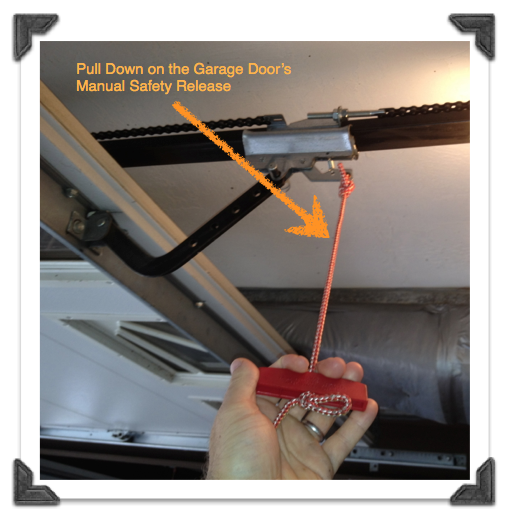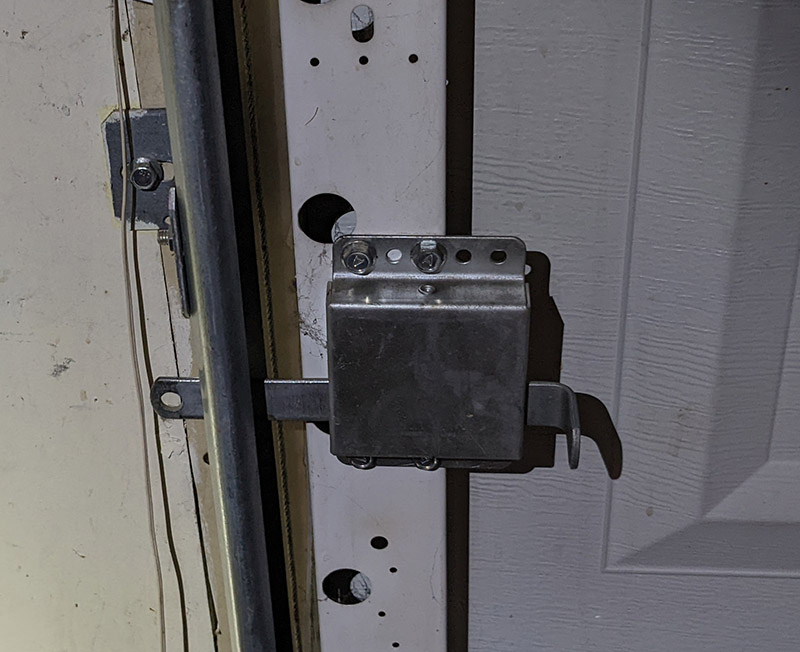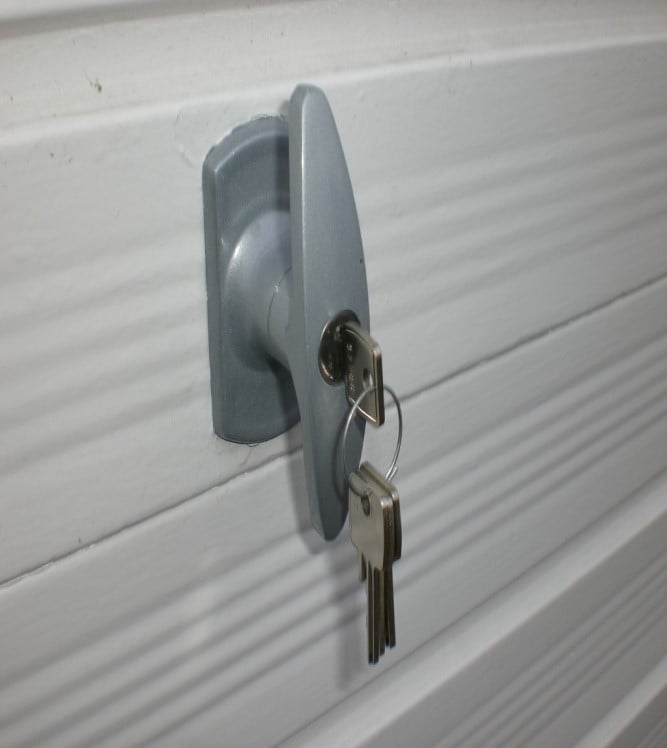To manually lock a garage door, slide the manual lock bar into the locking slot on the door track. Ensure the door is fully closed before locking.
Securing your garage door manually is a crucial step, especially when automatic mechanisms fail or during power outages. This simple yet effective method ensures that your garage remains safe from unauthorized access. Mastering the manual locking process is not only practical but also provides peace of mind.
Knowing how to lock your garage door manually is essential for every homeowner. It adds an extra layer of security and can be a lifesaver in situations where technology might let you down. With safety being a top priority for many, understanding the basics of manual garage door locking is a valuable skill. Let’s dive into the details of how you can achieve this added security measure with ease.
Introduction To Manual Garage Door Locking
garage doors need secure locks to protect valuables. Manual locking offers reliability without power. Understanding how to engage these locks is crucial for safety and security.
The Need For Manual Locking
Automatic garage door openers can fail. Power outages happen. Manual locks provide a backup security layer. They keep doors shut tight against intruders. They also ensure safety during emergencies.
Types Of Garage Doors And Their Locks
Garage doors come in several types. Each has unique locks. Knowing your door type is key for the right lock.
| Door Type | Lock Type |
|---|---|
| Tilt-Up Doors | Deadbolts, Slide Latches |
| Roll-Up Doors | Padlocks, Cylinder Locks |
| Sectional Doors | Hasp and Staple |

Credit: www.garagedoorspokane.com
Safety Precautions Before Locking
Before manually locking a garage door, safety comes first. It’s crucial to ensure the area is safe to prevent accidents or damage. Follow these steps to lock your garage door safely.
Inspecting The Door And Surroundings
- Check the tracks for any obstacles or debris.
- Look for wear or damage on the door itself.
- Ensure springs are intact and not broken.
- Verify cables are not frayed or snapped.
Ensuring Personal Safety
- Wear protective gloves to safeguard hands.
- Keep fingers away from joints and hinges.
- Do not wear loose clothing that might catch.
- Use steady footing to prevent slips.
Tools And Materials Needed
Securing your garage door manually is straightforward with the right tools. A few basic items will help you lock the door safely. Ensure you have everything listed below before you start.
List Of Necessary Equipment
- Vice grips or a C-clamp to hold the door in place
- Slide lock or latch for interior manual locking
- Drill with drill bits for installing locks
- Screwdriver set to adjust or remove screws
- Wrench set for bolt tightening
- Padlocks to secure the latch or lock
Substitute Tools For Emergencies
In case of an emergency, you may need to improvise. Here are alternatives that can act as substitute tools.
| Standard Tool | Substitute Tool |
|---|---|
| Vice grips or C-clamp | Heavy furniture or wood block |
| Slide lock or latch | Metal bar or wooden dowel |
| Drill with drill bits | Nail and hammer to start a pilot hole |
| Screwdriver set | Butter knife or coin |
| Wrench set | Adjustable pliers or pipe wrench |
| Padlocks | Zip ties or rope |

Credit: www.45thparallel.com
Step-by-step Manual Locking Guide
Today, we dive into a simple Step-by-Step Manual Locking Guide for your garage door. Whether it’s for added security or peace of mind, learning how to manually lock your garage door is a valuable skill. This guide will walk you through the basics of engaging both the internal and external lock mechanisms.
Engaging The Internal Lock
- Find the internal lock handle. This is usually located on the inside of your garage door.
- Slide the handle. Move it either to the left or right, depending on your door’s design.
- Listen for a click. This sound indicates the lock is in place.
Engaging the internal lock adds a layer of security from the inside. It’s quick and easy.
Securing The External Lock Mechanism
- Locate the external lock. It’s on the door’s outside.
- Insert your key. Turn it until the lock engages.
- Remove the key. Keep it in a safe place.
Securing the external lock mechanism provides additional safety. It ensures your garage door stays shut from the outside.
| Lock Type | Steps |
|---|---|
| Internal | Find handle, Slide, Listen for click |
| External | Locate lock, Insert key, Turn key, Remove key |
By following these steps, you can ensure your garage door is locked manually. This guide is designed to help you secure your garage quickly and efficiently.
Troubleshooting Common Locking Issues
Garage doors sometimes have problems locking. This section helps you fix those issues. We will look at common problems and how to solve them. Keep your garage safe by learning these tips.
Handling A Stuck Lock
A lock can get stuck. Here’s how to fix it:
- Check the lock for dirt or rust.
- Clean it with a wire brush or WD-40.
- Try the key again. It should turn now.
If the lock still doesn’t move, you might need a new one.
Dealing With A Jammed Garage Door
Sometimes the whole door gets jammed. Here’s what to do:
- Turn off the garage door opener.
- Check the tracks for any blockages.
- Remove anything blocking the tracks.
- Try opening the door manually.
If the door still won’t open, the springs might be the problem.
Enhancing Garage Door Security
Keeping your garage secure is crucial. A locked garage door shields your car, tools, and home. Let’s explore manual lock enhancements and tech upgrades for better security.
Additional Locking Mechanisms
Extra locks can prevent break-ins. Slide bolts and padlocks are simple yet effective. Install them on the inside for added security. Here’s how:
- Choose a heavy-duty slide bolt or padlock.
- Position it on the garage door track.
- Ensure it lines up with a pre-drilled hole or drill a new one.
- Slide the bolt or lock through the hole when you need extra security.
Remember to unlock these before opening your garage door to prevent damage.
Technological Upgrades For Better Security
Smart locks offer convenience and control. Pair them with security cameras for a robust system. Look at these tech upgrades:
| Upgrade | Benefits |
|---|---|
| Smart Garage Door Locks | Remote access, alerts, and scheduling. |
| Security Cameras | Real-time monitoring and recording. |
| Alarm Systems | Loud alerts during break-ins. |
For installation, consult a professional. They can integrate new tech with your current setup.
Manual locks and tech upgrades protect your garage. Choose the right combo for peace of mind.
Maintenance Tips For Longevity
Maintenance Tips for Longevity ensure your garage door lock works well for years. Proper care avoids frequent repairs. Follow these steps to keep your lock in top shape.
Regular Lock Maintenance Routines
- Check locks monthly: Look for wear or damage.
- Clean with mild soap: Wipe with a soft cloth.
- Lubricate moving parts: Use garage door lubricant.
- Tighten loose components: Use a screwdriver or wrench.
- Test lock mechanism: Ensure smooth operation.
When To Replace Locks And Parts
| Part | Signs of Wear | Action |
|---|---|---|
| Lock Cylinder | Key turns rough | Replace cylinder |
| Latch Assembly | Door doesn’t close tight | Adjust or replace latch |
| Locking Bars | Misalignment | Realign or replace bars |
Professional Help Vs. Diy
Deciding between professional help and a do-it-yourself approach for locking a garage door is crucial. This choice affects safety, cost, and peace of mind.
When To Call A Professional
Complex mechanisms or security systems often need a professional’s touch. If the garage door has an electronic or smart lock, it’s best to seek expert assistance. Professionals handle these issues daily. They bring the right tools and knowledge. Below are signs to watch for:
- Door doesn’t open or close properly
- Strange noises during operation
- Visible damage to locks or door mechanisms
Benefits Of Diy Locking Techniques
DIY locking brings several advantages. It’s often more cost-effective and improves skill sets. For simple lock mechanisms, a manual approach is feasible. Consider these DIY benefits:
- Immediate action without waiting for a professional
- Understanding your home’s security features better
- Saving money on service fees
Common tools like screwdrivers and padlocks can secure a door. Follow these steps for a basic manual lock:
- Close the door firmly
- Engage the manual lock by sliding the bolt
- Add a padlock for extra security

Credit: www.overheaddoorco.com
Frequently Asked Questions
Can You Manually Lock A Garage Door?
Yes, most garage doors can be manually locked using a key or a slide lock mechanism from the inside.
What Steps Lock A Garage Door Manually?
To lock a garage door manually, close the door, slide the manual lock into place, and secure it with a key if required.
Is It Safe To Manually Lock A Garage Door?
Manually locking a garage door is safe and adds an extra layer of security, especially if the automatic opener is disconnected.
Why Would You Lock A Garage Door Manually?
Manually locking a garage door is essential during power outages or when the automatic opener malfunctions for added security.
How Do You Ensure A Garage Door Stays Locked?
Regularly check the manual lock for wear and tear and ensure it engages fully to keep the garage door securely locked.
Conclusion
Securing your garage by manual locking doesn’t have to be complicated. Our step-by-step guide ensures a safe, theft-deterrent method that’s straightforward. Remember, a secure lock protects not just your garage, but your home too. Embrace this simple solution and enjoy peace of mind, knowing your property is safeguarded.




